1995 PONTIAC PONTIAC inflation pressure
[x] Cancel search: inflation pressurePage 170 of 354
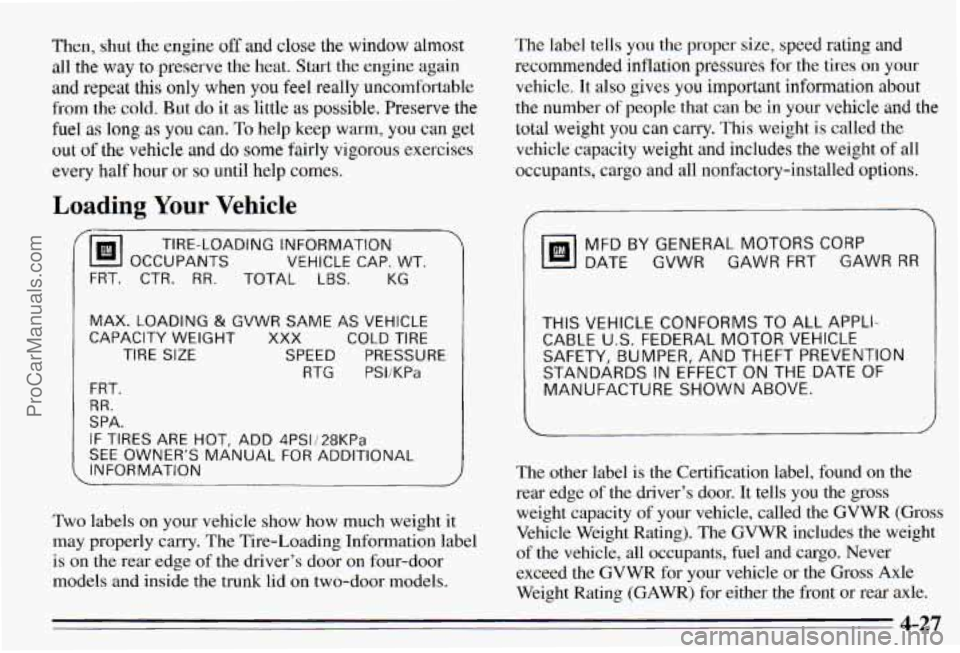
Then, shut the engine off and close the window almost
all the
way to preserve the heat, Start the engine again
and repeat this only when
you feel really uncomfortable
from the cold. But do
it as little as possible. Preserve the
he1 as long as you can. To help keep warm, you can get
out
of the vehicle and do sume fairly vigorous exercises
every half hour
or so until help comes.
Loading Your Vehicle
/bI OCCUPANTS
VEHICLE CAP. WT.
TIRE-LOADING INFORMATION
FRT.
CTR. RR. TOTAL LBS. KG
MAX. LOADING & GVWR SAME AS VEHICLE I
CAPACITY WEIGHT XXX COLD TIRE
TIRE
SIZE SPEED PRESSURE
RTG PSI/KPa
FRT.
RR.
SPA.
IF TIRES ARE HOT, ADD 4PS1/28KPa
SEE OWNER’S MANUAL
FOR ADDITIONAL
INFORMATiON
/
Two labels on your vehicle show how much weight it
may properly carry. The Tire-Loading Information label
is on
the rear edge of the driver’s door on four-door
models and inside the trunk lid on two-door models. The label tells you the proper
size, speed rating and
recommended inflation pressures
for the tires on your
vehicle.
It also gives you important information about
the number of people that can be in your vehicle and the
total weight
you can carry. This weight is called the
vehicle capacity weight and includes the weight
of all
occupants, cargo and all nonfactory-installed options.
MFD BY GENERAL MOTORS CORP
DATE GVWR GAWR FRT GAWR RR
THIS VEHICLE CONFORMS TO ALL APPLI-
CABLE
U.S. FEDERAL MOTOR VEHICLE
SAFETY, BUMPER, AND THEFT PREVENTION
STANDARDS IN EFFECT ON
THE DATE OF
MANUFACTURE SHOWN ABOVE.
The other label is the Certification label, found on the
rear edge of the driver’s door. It tells you the
gross
weight capacity of your vehicle, called the GVWR (Gross
Vehicle Weight Rating). The GVWR includes the weight of
the vehicle, all occupants, fuel and cargo. Never
exceed the GVWR for your vehicle or the Gross
Axle
Weight Rating (GAWR) for either the front or rear axle.
4-27
ProCarManuals.com
Page 211 of 354
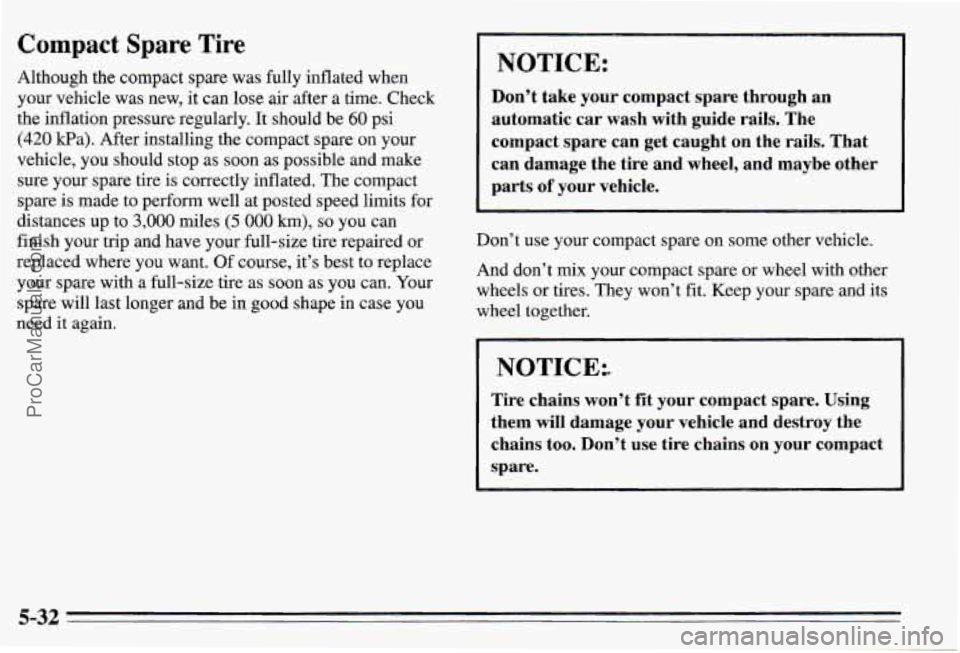
Compact Spare Tire
Although the compact spare was fully inflated when
your vehicle was new, it can lose air after a time. Check
the inflation pressure regularly. It should be
60 psi
(420 kPa). After installing the compact spare on your
vehicle,
you should stop as soon as possible and make
sure your spare tire is correctly inflated. The compact
spare is made to perform well at posted speed limits for
distances up to
3,000 miles (5-000 km), so you can
finish your trip and have your full-size tire repaired
or
replaced where you want. Of course, it’s best to replace
your spare with a full-size tire as soon as you can.
Your
spare will last longer and be in good shape in case you
need it again.
NOTICE:
Don’t take your compact spare through an
automatic car wash with guide rails. The
compact spare can get caught on the rails. That
can damage the tire and wheel, and maybe other
parts
of your vehicle.
Don’t use your compact spare on some other vehicle.
And don’t mix your compact spare
or wh.ee1 with other
wheels or tires. They won’t fit. Keep your spare and its
wheel together.
NOTICE:
Tire chains won’t fit your compact spare. Using
them will damage your vehicle and destroy the
chains too. Don’t use tire chains on your compact
spare.
5-32
ProCarManuals.com
Page 260 of 354
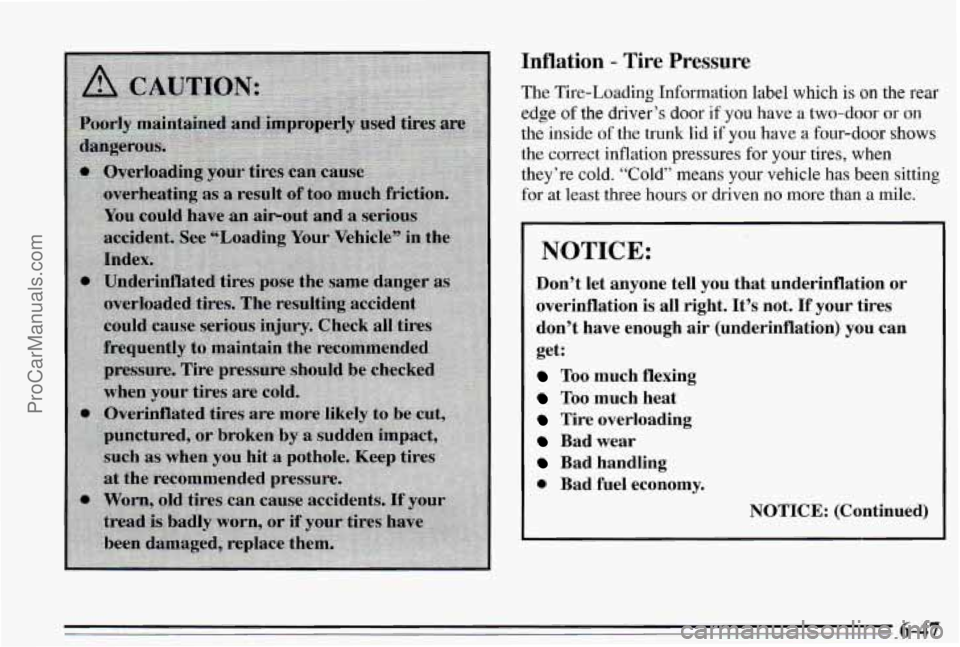
Mation - Tire Pressure
The Tire-Loading Information label which is on the rear
edge of the driver’s door if you have a two-door or on
the inside of the trunk lid if you have a four-door shows
the correct inflation pressures for your tires, when
they’re cold. “Cold” means your vehicle has been
sitting
for at least three hours or driven no more than a mile.
NOTICE:
Don’t let anyone tell you that underinflation or
overinflation is all right. It’s not. If your tires
don’t have enough air (underinflation) you can
get:
Too much flexing
Too much heat
Tire overloading
Bad wear
Bad handling
0 Bad fuel economy.
NOTICE: (Continued)
6-47 ProCarManuals.com
Page 261 of 354
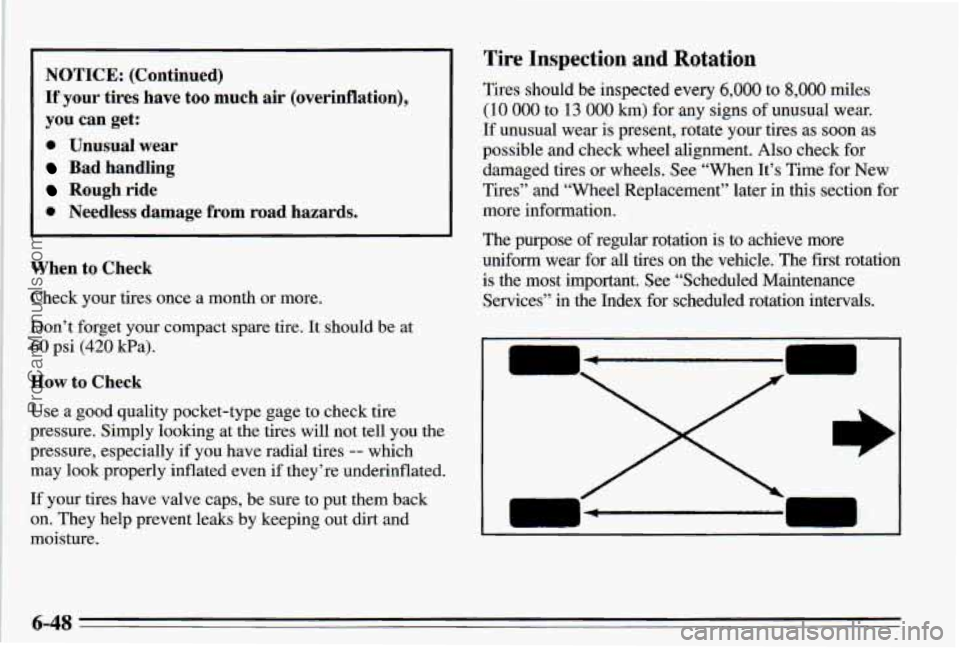
NOTICE: (Continued)
If your tires have too much air (overinflation),
you can get:
0 Unusual wear
Bad handling
Rough ride
0 Needless damage from road hazards.
P en to Check
Check your tires once a month or more.
,Don’t forget your compact spare tire.
It should be at
60 psi (420 kPa).
How to Check
Use a good quality pocket-type gage to check tire
pressure. Simply looking at the tires will not tell you the
pressure, especially if you have radial tires
-- which
may look properly inflated even
if they’re underinflated.
If your tires have valve caps, be sure to put them back
on. They help prevent leaks by keeping out dirt and
moisture.
Tire Inspection and Rotation
Tires should be inspected every 6,000 to 8,000 miles
(10 000 to 13 000 km) for any signs of unusual wear.
If unusual wear is present, rotate your tires as soon as
possible and check wheel alignment.
Also check for
damaged tires or wheels. See “When It’s Time for New
Tires” and “Wheel Replacement” later in this section for
more information.
The purpose of regularrotation is to achieve more
uniform wear for
all tires on the vehicle. The first rotation
is the most important. See “Scheduled Maintenance
Services”
in the Index for scheduled rotation intervals.
I
n
6-48
ProCarManuals.com
Page 262 of 354

When rotating your tires, always use the correct rotation
pattern shown here.
Don’t include the compact spare tire in
your tire rotation.
After the tires have been rotated, adjust the front
and
rear inflation pressures as shown on the Tire-Loading
Information label. Make
certain that all wheel nuts are
properly tightened. See “Wheel Nut Torque” in the
Index.
When It’s Time for New Tires
.. .
One way to tell when it’s
time for new tires
is to
check the treadwear
indicators, which will
appear when your tires have
only 1/16 inch (1.6 mm) or
less
of tread remaining.
You need a new tire if
You can see the indicators at three or more places
around the tire.
You can see cord or fabric showing through the tire’s
rubber.
The tread or sidewall is cracked, cut or snagged deep
enough to show cord or fabric.
The tire has a bump, bulge or split.
0 The tire has a puncture, cut, or other damage that
can’t be repaired well because of the size
or location
of the damage.
6-49 ProCarManuals.com
Page 323 of 354
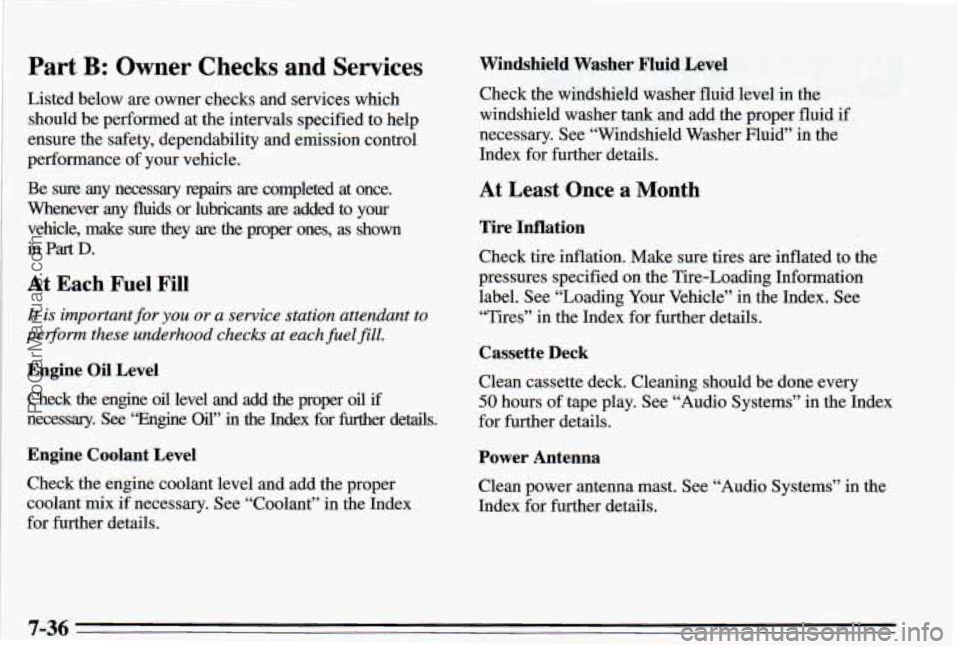
Part B: Owner Checks and Services
Listed below are owner checks and services which
should be performed at the intervals specified to help
ensure the safety, dependability and emission control
performance of your vehicle.
Be sure any necessary repairs are completed at
once.
Whenever any fluids or lubricants are added to your
vehicle, make
sure they are the proper ones, as shown
in Part D.
At Each Fuel Fill
It is important for you or a service station attendant to
perform these underhood checks at each
fuel fill.
Engine Oil Level
Check the engine oil level and add the proper oil if
necessary.
See “Engine Oil” in the hdex for further details.
Engine Coolant Level
Check the engine coolant level and add the proper
coolant mix if necessary. See “Coolant” in the Index
for further details.
Windshield Washer Fluid LeveI
Check the windshield washer fluid level in the
windshield washer tank and add the proper fluid
if
necessary. See “Windshield Washer Fluid” in the
Index for further details.
At Least Once a Month
Tire Inflation
Check tire inflation. Make sure tires are inflated to the
pressures specified on the Tire-Loading Information
label. See “Loading Your Vehicle”
in the Index. See
“Tires” in the Index for further details.
Cassette Deck
Clean cassette deck. Cleaning should be done every
50 hours of tape play. See “Audio Systems” in the Index
for further details.
Power Antenna
Clean power antenna mast. See “Audio Systems” in the
Index for further details.
7-36 ProCarManuals.com
Page 347 of 354

Ignition Key Positions .......................... 2-12
Ignition Switch
................................. 2- 12
Inflation
- Tire Pressure .......................... 6-47
Inside Daymight Rearview Mirror ................. 2-39
Brake System
............................... 7-39
Exhaust Systems
............................. 7-39
Restraint Systems
............................ 7-39
Axle Boot and Seal
......................... 7-39
Instrument Panel
............................... 2-42
Instrument Panel Intensity Control
................. 2-35
Instrument Panel, Cleaning
....................... 6-57
Interior Lamps
................................. 2-36
Jack, Tire
.................................... 5-24
Jump Starting
................................... 5-2
Key Lock Cylinders, Maintenance
................ 7-37
Key Reminder Warning
.......................... 2- 13
Lamp, Dome
................................. 2-38
Inspections
Steering. Suspension and Front-Wheel-Drive
ThrottleLinkage
............................. 7-39
Keys
.......................................... 2-1
Lamp, Malfunction Indicator
...................... 2-56
Daytime Running
............................ 2-35
Lamps
........................................ 2-34
Battery Saver
............................... 2-36
Interior
.................................... 2-36 OnReminder
................................ 2-35
Sustained Interior Illumination
.................. 2-37
Lane Change Indicator
........................... 2-29
Larger Children. Safety Belt Use
................... 1-51
Latches, Front Seatback
........................... 1-4
Leaving Your Vehicle
............................. 2-4
Air Bag Readiness
...................... 1-24, 2-51
Anti-Lock Brake System Active
................ 2-54
Brake System Warning
........................ 2-52
Charging System
............................. 2-50
Engine Coolant Temperature
................... 2-54
Low Coolant
........................... 2-55, 6-20
Low Oil Level
.......................... 2-58, 6- 11
Oil Warning
................................. 2-57
Safety Belt Reminder
..................... 1-5, 2-50
Second Gear Start
............................ 2-20
Service Engine Soon
.......................... 2-56
Loading Your Vehicle ........................... 4-27
Automatic Door
.............................. 2-4
PowerDoor
.................................. 2-4
Steering Column
............................. 7-38
Torque
..................................... 2-24
Window
.................................... 2-27
...................................... Panel 2-35
Leaving Your Vehicle with the Engine Running
....... 2-23
Lights
Anti-Lock Brake System Warning
........... 2-53, 4-7
LowFuel
................................... 2-49
Security
.................................... 2-58
Lighter
....................................... 2-45
Locks Door
....................................... 2-3
Trunk
....................................... 2-8
9-6 ProCarManuals.com